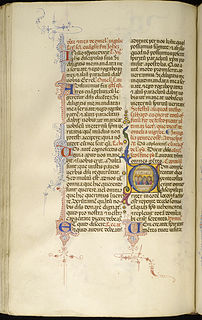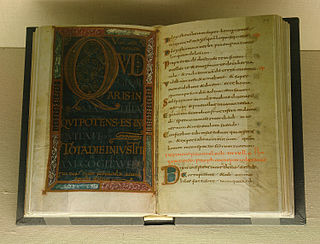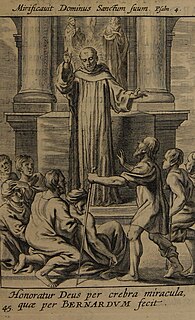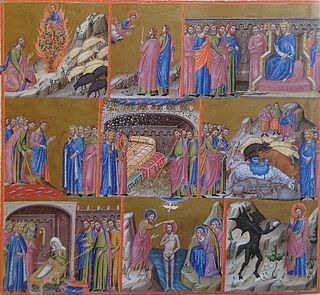
The Roman Breviary is the liturgical book of the Latin liturgical rites of the Catholic Church containing the public or canonical prayers, hymns, the Psalms, readings, and notations for everyday use, especially by bishops, priests, and deacons in the Divine Office.

A psalter is a volume containing the Book of Psalms, often with other devotional material bound in as well, such as a liturgical calendar and litany of the Saints. Until the emergence of the book of hours in the Late Middle Ages, psalters were the books most widely owned by wealthy lay persons. They were commonly used for learning to read. Many Psalters were richly illuminated, and they include some of the most spectacular surviving examples of medieval book art.
The Antiphonary tonary missal of St. Benigne was written in the last years of the 10th century, when the Abbot William of Volpiano at St. Benignus of Dijon reformed the liturgy of several monasteries in Burgundy. The chant manuscript records mainly Western plainchant of the Roman-Frankish proper mass and part of the chant sung during the matins, but unlike the common form of the Gradual and of the Antiphonary, William organized his manuscript according to the chant genre, and these sections were subdivided into eight parts according to the octoechos. This disposition followed the order of a tonary, but William of Volpiano wrote not only the incipits of the classified chant, he wrote the complete chant text with the music in central French neumes which were still written in campo aperto, and added a second alphabetic notation of his own invention for the melodic structure of the codified chant.

The Gallican Rite is a historical version of Christian liturgy and other ritual practices in Western Christianity. It is not a single rite but a family of rites within the Latin Church, which comprised the majority use of most of Western Christianity for the greater part of the 1st millennium AD. The rites first developed in the early centuries as the Syriac-Greek rites of Jerusalem and Antioch and were first translated into Latin in various parts of the Western Roman Empire Praetorian prefecture of Gaul. By the 5th century, it was well established in the Roman civil diocese of Gaul, an early center of Christianity. Ireland is also known to have had a form of this Gallican Liturgy mixed with Celtic customs.

The term "Celtic Rite" is applied to the various liturgical rites used in Celtic Christianity in Britain, Ireland and Brittany and the monasteries founded by St. Columbanus and Saint Catald in France, Germany, Switzerland, and Italy during the early middle ages. The term does not imply homogeneity; the evidence, scanty and fragmentary as it is, is in favour of considerable diversity.

The Luttrell Psalter is an illuminated psalter commissioned by Sir Geoffrey Luttrell (1276–1345), lord of the manor of Irnham in Lincolnshire, written and illustrated on parchment circa 1320–1340 in England by anonymous scribes and artists.
The Saint Martial School was a medieval school of music composition centered in the Abbey of Saint Martial, Limoges, France. It is known for the composition of tropes, sequences, and early organum. In this respect, it was an important precursor to the Notre Dame School. Adémar de Chabannes and his nephew Roger de Chabannes were important proponents of this school.

The Utrecht Psalter is a ninth-century illuminated psalter which is a key masterpiece of Carolingian art; it is probably the most valuable manuscript in the Netherlands. It is famous for its 166 lively pen illustrations, with one accompanying each psalm and the other texts in the manuscript. The precise purpose of these illustrations, and the extent of their dependence on earlier models, have been matters of art-historical controversy. The psalter spent the period between about 1000 to 1640 in England, where it had a profound influence on Anglo-Saxon art, giving rise to what is known as the "Utrecht style". It was copied at least three times in the Middle Ages. A complete facsimile edition of the psalter was made in 1875, and another in 1984 (Graz).

The Latin Psalters are the translations of the Book of Psalms into the Latin language. They are the premier liturgical resource used in the Liturgy of the Hours of the Latin Rites of the Roman Catholic Church.
A tonary is a liturgical book in the Western Christian Church which lists by incipit various items of Gregorian chant according to the Gregorian mode (tonus) of their melodies within the eight-mode system. Tonaries often include Office antiphons, the mode of which determines the recitation formula for the accompanying text, but a tonary may also or instead list responsories or Mass chants not associated with formulaic recitation. Although some tonaries are stand-alone works, they were frequently used as an appendix to other liturgical books such as antiphonaries, graduals, tropers, and prosers, and are often included in collections of musical treatises.

The Stowe Psalter is a psalter from the "2nd or 3rd quarter of the 11th century", at the end of Anglo-Saxon art. The text includes the Gallican version of the Psalms, followed by the Canticles with an interlinear Old English gloss.

The St Albans Psalter, also known as the Albani Psalter or the Psalter of Christina of Markyate, is an English illuminated manuscript, one of several psalters known to have been created at or for St Albans Abbey in the 12th century. It is widely considered to be one of the most important examples of English Romanesque book production; it is of almost unprecedented lavishness of decoration, with over forty full-page miniatures, and contains a number of iconographic innovations that would endure throughout the Middle Ages. It also contains the earliest surviving example of French literature, the Chanson de St Alexis or Vie de St Alexis, and it was probably commissioned by an identifiable man and owned by an identifiable woman. Since the early 19th century it has been owned by the church of St. Godehard, but is now stored and administered at the nearby Dombibliothek. A single leaf from the manuscript is at the Schnütgen Museum, Cologne; one further leaf, and one further cutting, are missing from the volume, their whereabouts unknown.

The Psalter of Oswald also called the Ramsey Psalter is an Anglo-Saxon illuminated psalter of the last quarter of the tenth century. Its script and decoration suggest that it was made at Winchester, but certain liturgical features have suggested that it was intended for use at the Benedictine monastery of Ramsey Abbey, or for the personal use of Ramsey's founder St Oswald.
The so-called Celtic Mass is the liturgy of the Christian office of the Mass as it was celebrated in the so-called Celtic Christianity of the Early Middle Ages.

Psalm 4 is the fourth psalm from the Book of Psalms. Its authorship is traditionally assigned to king David, but his authorship is not accepted by modern scholars. The psalm's Latin title is Cum invocarem.

The Isabella Breviary is a late 15th-century illuminated manuscript housed in the British Library, London. Queen Isabella I was given the manuscript shortly before 1497 by her ambassador Francisco de Rojas to commemorate the double marriage of her children and the children of Emperor Maximilian of Austria and Duchess Mary of Burgundy.

Beatus vir are the first words in the Latin Vulgate Bible of both Psalm 1 and Psalm 112. In each case, the words are used to refer to frequent and significant uses of these psalms in art, although the two psalms are prominent in different fields, art in the case of Psalm 1 and music in the case of Psalm 112. In psalter manuscripts, the initial letter B of Beatus is often rendered prominently as a Beatus initial.

The Great Canterbury Psalter is an early 13th- and mid 14th-century illuminated manuscript with the shelfmark MS lat. 8846 in the Bibliothèque nationale de France in Paris. It was made in two different locations and moments in time: at Canterbury around 1200 and in Catalonia around 1340. It is the last of a series of copies of the Utrecht Psalter made in Canterbury, following the Harley Psalter and the Eadwine Psalter.

The Stuttgart Psalter is a richly illuminated 9th-century psalter, considered one of the most significant of the Carolingian period. Written in Carolingian minuscule, it contains 316 images illustrating the Book of Psalms according to the Gallican Rite. It has been archived since the late 18th century at the Württembergische Landesbibliothek in Stuttgart.

The Psalter of Caimín is a medieval Irish illuminated manuscript likely produced in the 11th century, possibly on the island of Inis Cealtra in Lough Derg. It is badly damaged, with only fragments surviving. These consist of six folios, containing verses 1-16 and 33-116 of Psalm 118, a psalm that would have had 176 versus in total, and was a favourite of the early Irish church. It is possible that the Psalter only ever consisted of this full psalm, perhaps also with notes and commentary, although it may have been much larger, containing the entire Psalter. It kept in the library of University College Dublin (MS.A.i)















